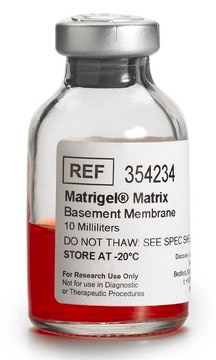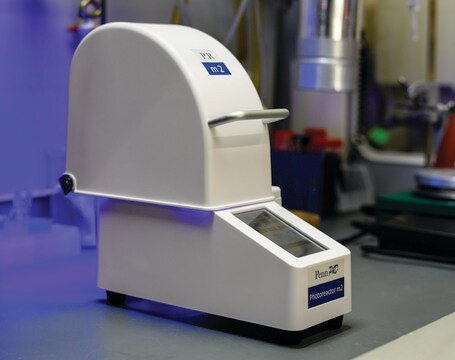ECM550
QCM ECMatrix Cell Invasion Assay, 24-well (8 µm), colorimetric
The CHEMICON Cell Invasion Assay Kit uses a 24-well plate, with 8 um pores, which provides an efficient system for evaluating the invasion of tumor cells through a basement membrane model.
Synonym(s):
Basement membrane cell invasion assay
Sign Into View Organizational & Contract Pricing
All Photos(3)
About This Item
UNSPSC Code:
12352207
eCl@ss:
32161000
NACRES:
NA.84
Recommended Products
Quality Level
species reactivity
vertebrates
manufacturer/tradename
Chemicon®
QCM
technique(s)
cell based assay: suitable
detection method
colorimetric
shipped in
wet ice
General description
Also available: Cell Comb Scratch Assay! Get biochemical data from a scratch assay!Click Here
Introduction
Invasion through the extracellular matrix (ECM) is an important step in tumor metastasis. Cancer cells initiate invasion by adhering to and spreading along the blood vessel wall. Proteolytic enzymes, such as MMP collagenases, dissolve tiny holes in the sheath-like covering (basement membrane) surrounding the blood vessels to allow cancer cells to invade.
The CHEMICON Cell Invasion Assay Kit provides an efficient system for evaluating the invasion of tumor cells through a basement membrane model. The kit utilizes ECMatrix, a reconstituted basement membrane matrix of proteins derived from the Engelbreth Holm-Swarm (EHS) mouse tumor. We examined the kit′s performance using human fibrosarcoma (HT-1080) and non-invasive fibroblasts (NIH3T3).
The CHEMICON Cell Invasion Assay Kit is ideal for evaluation of invasive tumor cells. Each CHEMICON Cell Invasion Assay Kit contains sufficient reagents for the evaluation of 12 samples.
The CHEMICON Cell Invasion Assay Kit is intended for research use only; not for diagnostic or therapeutic applications.
Test Principle:
The CHEMICON Cell Invasion Assay is performed in an Invasion Chamber, a 24-well tissue culture plate with 12 cell culture inserts. The inserts contain an 8 μm pore size polycarbonate membrane, over which a thin layer of ECMatrixTM is dried. The ECM layer occludes the membrane pores, blocking non-invasive cells from migrating through. Invasive cells, on the other hand, migrate through the ECM layer and cling to the bottom of the polycarbonate membrane.
Application:
The CHEMICON Cell Invasion Assay Kit is ideal for evaluation of invasive tumor cells. Each CHEMICON Cell Invasion Assay Kit contains sufficient reagents for the evaluation of 12 samples.
The CHEMICON Cell Invasion Assay Kit is intended for research use only; not for diagnostic or therapeutic applications.
Introduction
Invasion through the extracellular matrix (ECM) is an important step in tumor metastasis. Cancer cells initiate invasion by adhering to and spreading along the blood vessel wall. Proteolytic enzymes, such as MMP collagenases, dissolve tiny holes in the sheath-like covering (basement membrane) surrounding the blood vessels to allow cancer cells to invade.
The CHEMICON Cell Invasion Assay Kit provides an efficient system for evaluating the invasion of tumor cells through a basement membrane model. The kit utilizes ECMatrix, a reconstituted basement membrane matrix of proteins derived from the Engelbreth Holm-Swarm (EHS) mouse tumor. We examined the kit′s performance using human fibrosarcoma (HT-1080) and non-invasive fibroblasts (NIH3T3).
The CHEMICON Cell Invasion Assay Kit is ideal for evaluation of invasive tumor cells. Each CHEMICON Cell Invasion Assay Kit contains sufficient reagents for the evaluation of 12 samples.
The CHEMICON Cell Invasion Assay Kit is intended for research use only; not for diagnostic or therapeutic applications.
Test Principle:
The CHEMICON Cell Invasion Assay is performed in an Invasion Chamber, a 24-well tissue culture plate with 12 cell culture inserts. The inserts contain an 8 μm pore size polycarbonate membrane, over which a thin layer of ECMatrixTM is dried. The ECM layer occludes the membrane pores, blocking non-invasive cells from migrating through. Invasive cells, on the other hand, migrate through the ECM layer and cling to the bottom of the polycarbonate membrane.
Application:
The CHEMICON Cell Invasion Assay Kit is ideal for evaluation of invasive tumor cells. Each CHEMICON Cell Invasion Assay Kit contains sufficient reagents for the evaluation of 12 samples.
The CHEMICON Cell Invasion Assay Kit is intended for research use only; not for diagnostic or therapeutic applications.
Application
Detection of migrating cells is via crystal violet stain.
Research Category
Cell Structure
Cell Structure
Packaging
12 wells
Components
Invasion Chamber: (Part No. 70019) One 24-well plate with 12 ECMatrixTM layered cell culture inserts.
Cell Stain: (Part No. 20294) One 10 mL bottle.
Cotton Swabs: (Part No. 10202) 24 each.
Forceps: (Part No. 10203) One each.
Cell Stain: (Part No. 20294) One 10 mL bottle.
Cotton Swabs: (Part No. 10202) 24 each.
Forceps: (Part No. 10203) One each.
Storage and Stability
Store kit materials at 2-8°C for up to 6 months. Do not freeze.
Legal Information
CHEMICON is a registered trademark of Merck KGaA, Darmstadt, Germany
Disclaimer
Unless otherwise stated in our catalog or other company documentation accompanying the product(s), our products are intended for research use only and are not to be used for any other purpose, which includes but is not limited to, unauthorized commercial uses, in vitro diagnostic uses, ex vivo or in vivo therapeutic uses or any type of consumption or application to humans or animals.
Storage Class Code
10-13 - German Storage Class 10 to 13
WGK
WGK 1
Certificates of Analysis (COA)
Search for Certificates of Analysis (COA) by entering the products Lot/Batch Number. Lot and Batch Numbers can be found on a product’s label following the words ‘Lot’ or ‘Batch’.
Already Own This Product?
Find documentation for the products that you have recently purchased in the Document Library.
Down-regulation of JAK1 by RNA interference inhibits growth of the lung cancer cell line A549 and interferes with the PI3K/mTOR pathway.
Dan Liu,Yi Huang,Jing Zeng,Bojiang Chen,Na Huang,Na Guo,Lunxu Liu,Hong Xu,Xianming Mo,Weimin Li
Journal of Cancer Research and Clinical Oncology null
Jung-Sun Park et al.
Journal of pharmaceutical sciences, 97(9), 4011-4019 (2008-02-02)
All-trans retinoic acid (ATRA)-incorporated nanoparticles of methoxy poly(ethylene glycol) (MPEG)-grafted chitosan were prepared through ion-complex formation between ATRA and chitosan. This nanoparticle has around 100 nm of diameter and favorable reconstitution properties. ATRA-incorporated nanoparticles has almost similar cytotoxicity against CT-26
Inhibition of CD44 expression in hepatocellular carcinoma cells enhances apoptosis, chemosensitivity, and reduces tumorigenesis and invasion.
Zhigang Xie,Pei Feng Choong,Lai Fong Poon,Jianbiao Zhou,Jiaying Khng et al.
Cancer Chemotherapy and Pharmacology null
Epigenetic disruption of cadherin-11 in human cancer metastasis.
F Javier Carmona,Alberto Villanueva,August Vidal,Clara Mu,Sara Puertas,Rosa M Penin et al.
The Journal of Pathology null
RhoBTB2 (DBC2) functions as tumor suppressor via inhibiting proliferation, preventing colony formation and inducing apoptosis in breast cancer cells.
Mao H, Zhang L, Yang Y, Sun J, Deng B, Feng J, Shao Q, Feng A, Song B, Qu X
Gene null
Our team of scientists has experience in all areas of research including Life Science, Material Science, Chemical Synthesis, Chromatography, Analytical and many others.
Contact Technical Service






